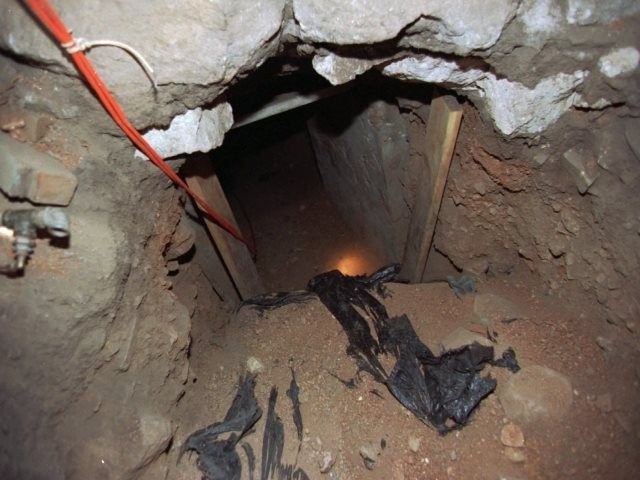Results 1 to 1 of 1
Thread Information
Users Browsing this Thread
There are currently 1 users browsing this thread. (0 members and 1 guests)
-
12-13-2016, 03:45 PM #1
DEA: 224 Mexican Cartel Tunnels Found Since 1990
DEA: 224 Mexican Cartel Tunnels Found Since 1990
 AP File Photo/John Miller
AP File Photo/John Miller
by EDWIN MORA13 Dec 20161
U.S. authorities have uncovered and destroyed 224 tunnels used to smuggle bulk quantities of illicit drugs along the U.S.-Mexico border since 1990–including 22 discovered in the last two years alone–reports the DEA in its latest National Drug Threat Assessment.
According to the threat assessment report, not all drug trafficking tunnels throughout the southwest cross into the United States.
Of the 224 tunnels discovered along the southwest border (SWB) between 1990 and March 2016, 185 crossed into the U.S.
The report notes that the tunnels have primarily been discovered in Arizona and California and are commonly used by the Sinaloa Cartel, one of the oldest and most established drug trafficking groups with “the most expansive international footprint amongst Mexican cartels.”
In 2013, the Office of the Inspector General (OIG) at the U.S. Department of Homeland Security (DHS) determined that tunnels along the southwest border are “a significant and growing threat to border security.”
The DEA points out tunnels tend to originate in Mexico and lead to a stash house on the U.S. side of the border.
“These tunnels typically have entrances in discreet places, such as private residences or warehouses, to avoid law enforcement suspicion,” it adds.
The assessment notes that Mexican cartels, officially known as Transnational Criminal Organizations (TCO), maintain control of lucrative smuggling routes into the United States used to traffic “multi-ton quantities” of illegal drugs on an annual basis, primarily heroin, which has been responsible for an unprecedented number of U.S. overdose deaths in recent years.
A map included in the report shows that Mexican TCOs, primarily the Sinaloa cartel, maintain influence across the United States, with hubs in nearly every single state in the country.
In its threat assessment report, the DEA explains:The poly-drug portfolio maintained by these Mexican TCOs consists primarily of heroin, methamphetamine, cocaine, marijuana, and, to a lesser extent, fentanyl.
Once these drugs are smuggled across the Mexican border, they are delivered to consumer markets in the United States using transportation routes and distribution cells that Mexican TCOs oversee both directly and indirectly. Mexican TCOs are constantly looking to expand their presence in the United States, particularly in heroin markets.
The use of subterranean tunnels is one of the many smuggling techniques used by drug traffickers.
“These tunnels are primarily used to smuggle ton quantities of marijuana, though there are instances of other illicit drugs commingled in these shipments,” reports the DEA, adding:
As of March 2016, there have been a total of 225 tunnels discovered on U.S. borders since 1990: 224 on the SWB (185 of these crossed into the United States), one on the Northern Border (which crossed into the United States). In Fiscal Year (FY) 2015, eight tunnels were discovered, compared to 14 tunnels discovered in FY 2014.
The DEA acknowledges that Mexican drug cartels smuggle the majority of their illicit contraband into the United States over land through the Southwest border.
Moreover, it notes that “there is potential for increased growth and use” of ultralight aircraft and unmanned aerial systems (UASs), or “drones, to traffic drugs into the United States.
Mexican cartels are expected to remain unrivaled in the foreseeable future as the “greatest criminal drug threat” facing the United States.
“No other organization currently possesses an infrastructure that can rival Mexican TCO dominance over the U.S. drug trade,” reports the DEA.
http://www.breitbart.com/texas/2016/...nd-since-1990/
NO AMNESTY
Don't reward the criminal actions of millions of illegal aliens by giving them citizenship.
Sign in and post comments here.
Please support our fight against illegal immigration by joining ALIPAC's email alerts here https://eepurl.com/cktGTn
Similar Threads
-
Three Mexican Cartel Tunnels Discovered Under US Soil This Week
By HAPPY2BME in forum illegal immigration News Stories & ReportsReplies: 0Last Post: 04-06-2014, 01:37 AM -
Fast and Furious Guns Found in Mexican Cartel Enforcer's Hom
By AirborneSapper7 in forum illegal immigration News Stories & ReportsReplies: 2Last Post: 10-10-2011, 09:29 AM -
U.S. Citizen, Kidnapped by Mexican Cartel; found dead
By Creoleguy32 in forum illegal immigration News Stories & ReportsReplies: 4Last Post: 09-12-2010, 02:54 PM -
13 shooting victims found in Mexican cartel region
By jamesw62 in forum Other Topics News and IssuesReplies: 0Last Post: 12-06-2008, 02:17 PM


 LinkBack URL
LinkBack URL About LinkBacks
About LinkBacks




 Reply With Quote
Reply With Quote


As Sen. Cortez Masto Scuttles Mayorkas' Impeachment, Illegal...
04-18-2024, 06:27 AM in Americans Killed By illegal immigrants / illegals